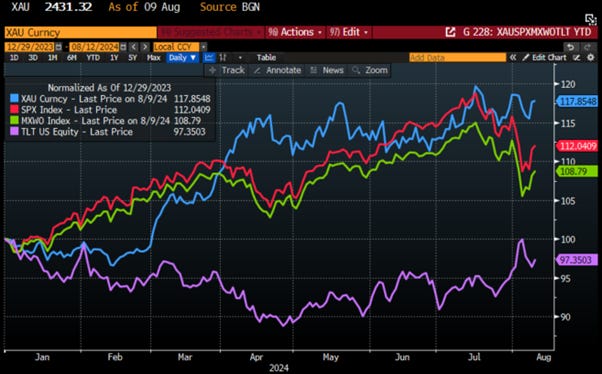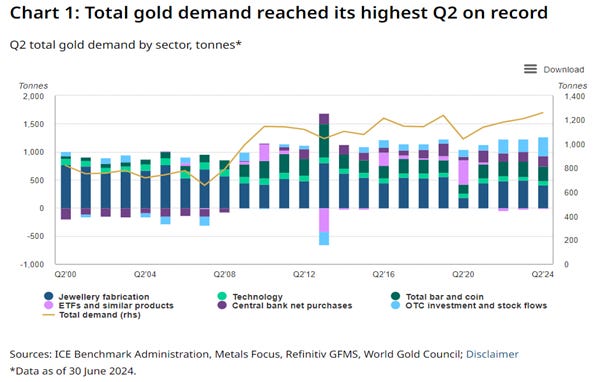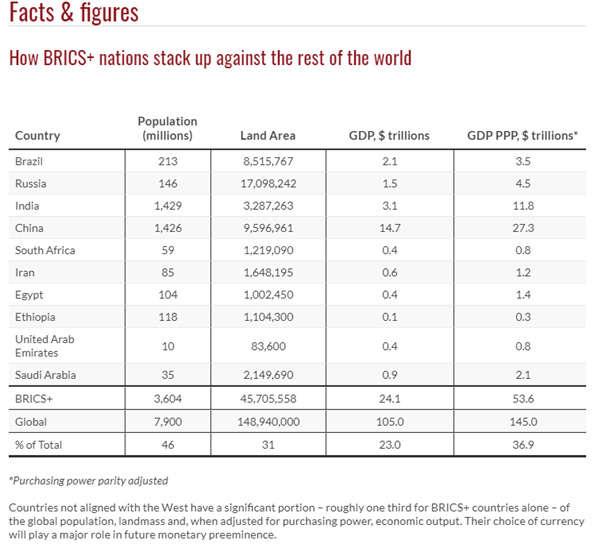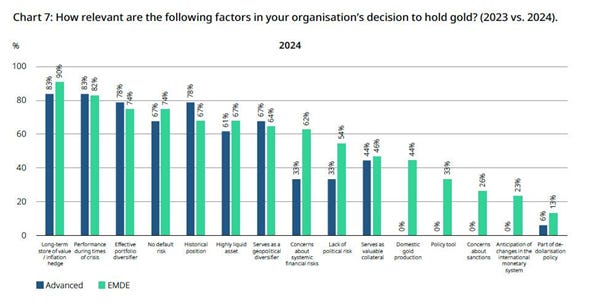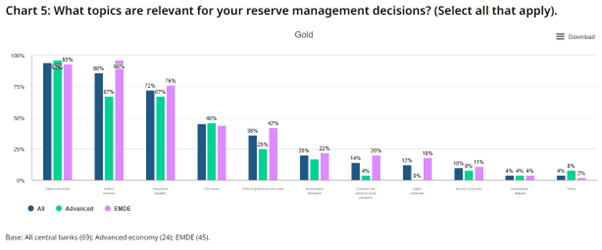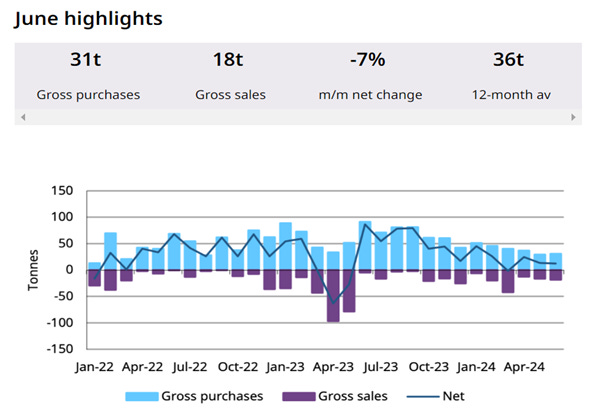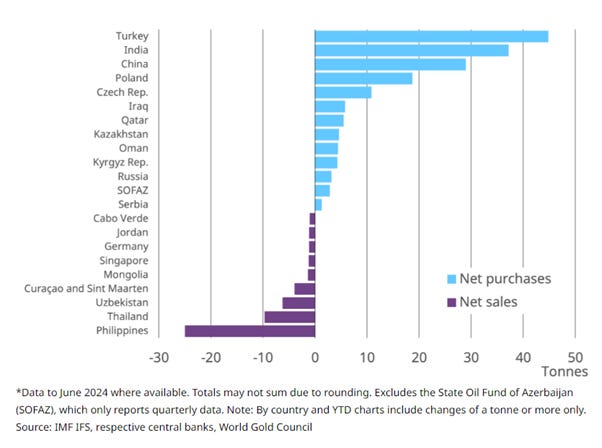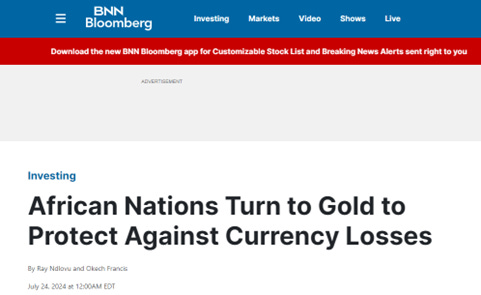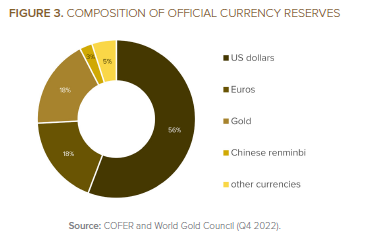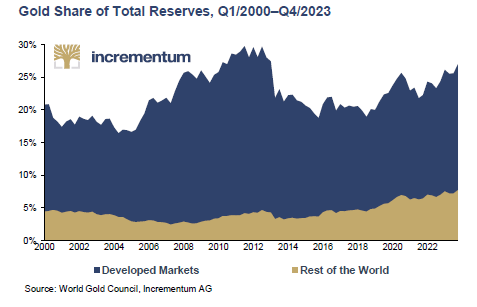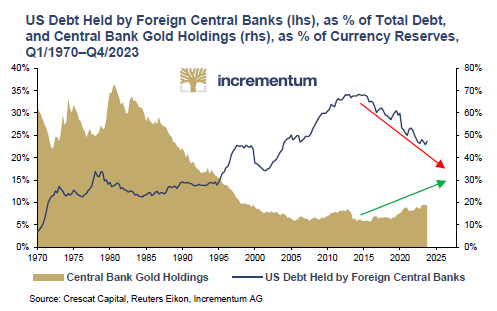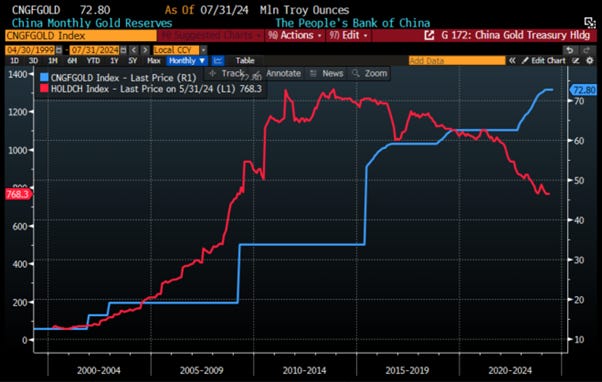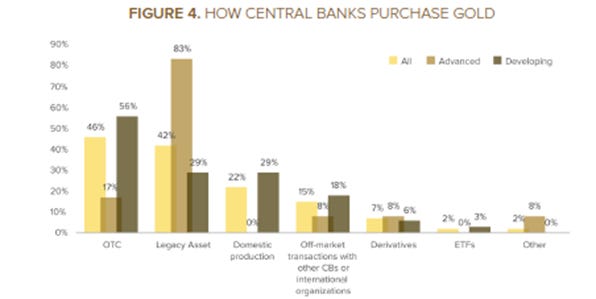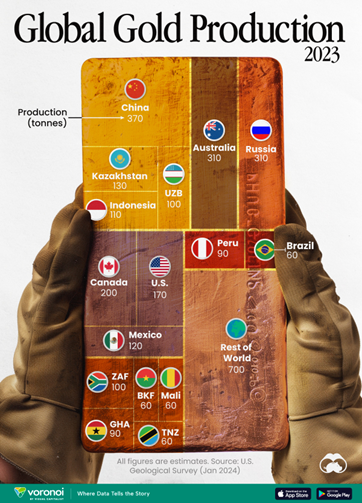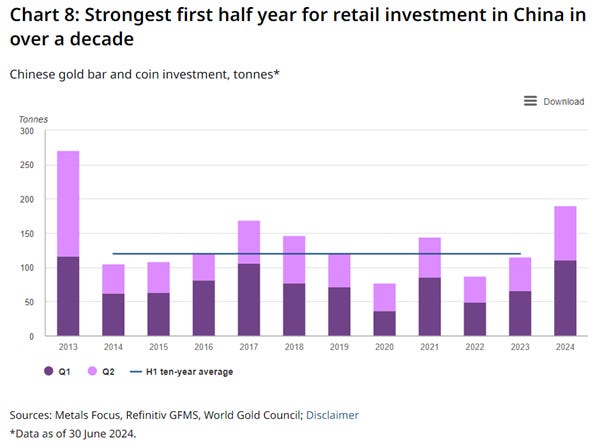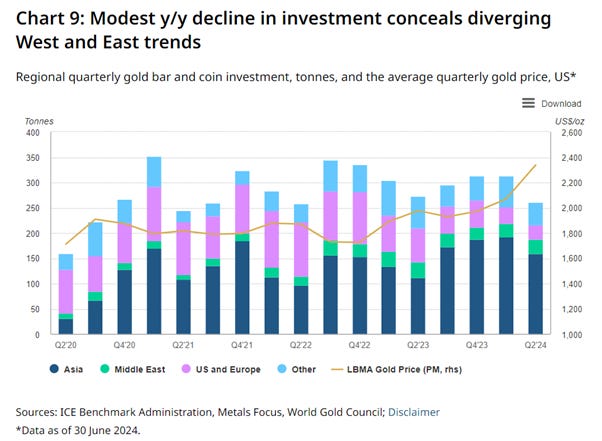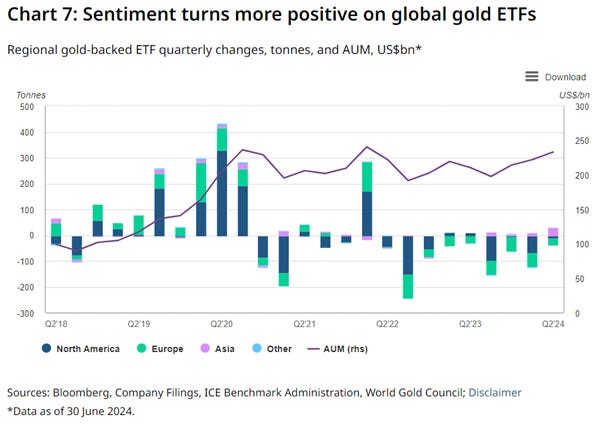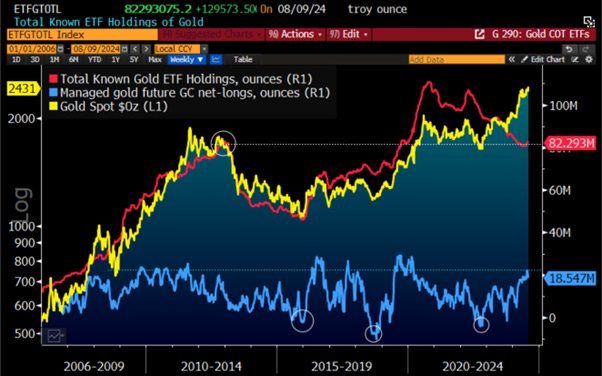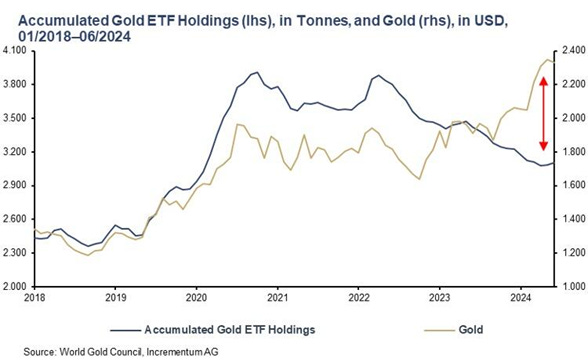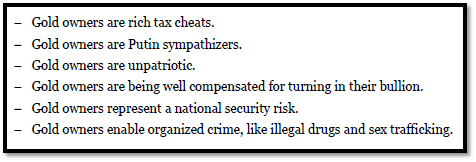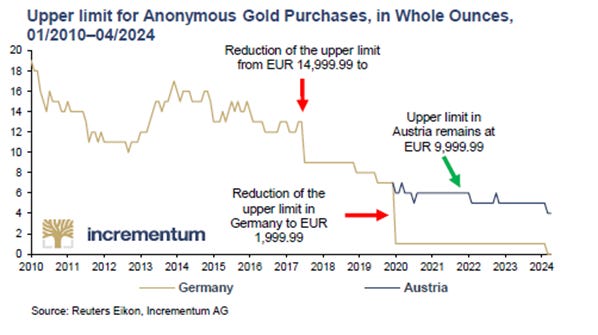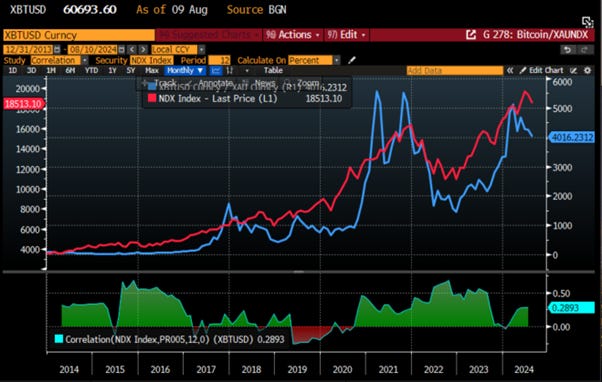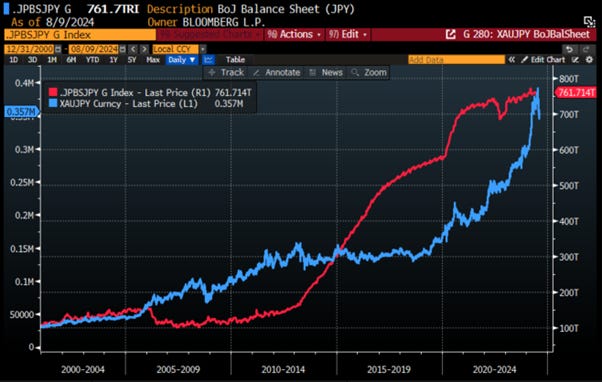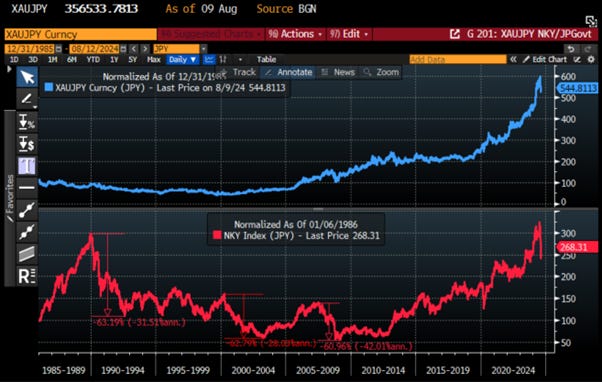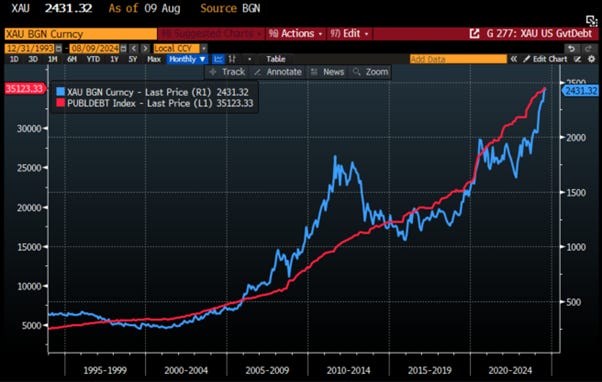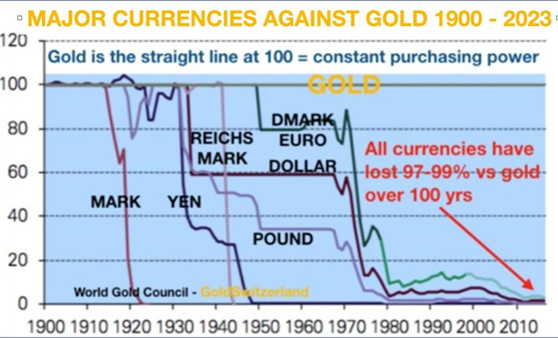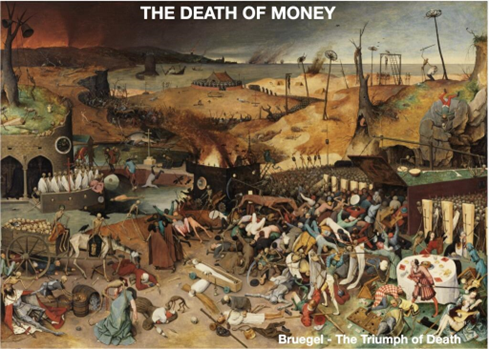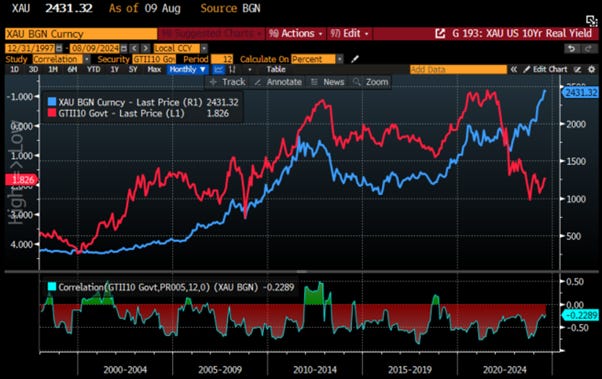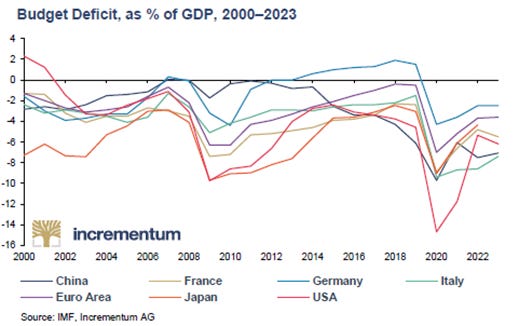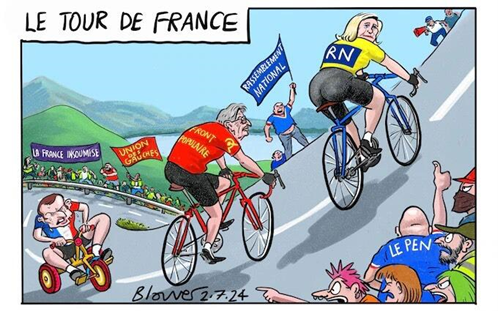In Gold Who Trusts?
While Wall Street bankers and the financial mass media like to denigrate gold as a barbaric relic and a shiny piece of rock, seasoned investors know that, contrary to a banker, numbers never lie. As a matter of fact, gold has delivered better returns, not only since the start of the COVID pandemic but also year-to-date, compared to US equities (S&P 500), international equities (MSCI World Index), and long-dated government bonds (iShares 20+ Year Treasury Bond ETF (TLT US)).
Performance of $100 invested in physical gold (blue line); S&P 500 index (red line); MSCI World (green line); iShares 20+ Year Treasury Bond ETF (TLT US) (purple line) since the start of 2024.
In this context, investors should consider what’s driving the current gold rush and In Gold, Who Trusts? Before diving into the recent surge in gold prices, which has been fuelled by the weaponization of the USD and Keynesian policies and soaring government debt, it’s important to understand gold's cultural significance across the world.
In China, gold is traditionally given as gifts for special occasions, such as newborns receiving tiny gold necklaces or bracelets, and ornate 24-carat jewellery is bought during the Chinese New Year. Gold has been valued in China since the Han Dynasty, but its demand surged during the Six Dynasties with the advent of Buddhism. Today, China is the world’s largest gold market, driven by increasing affluence and a belief that gold signifies financial wisdom and good fortune.
In India, gold holds a central cultural role as a store of value, symbol of wealth, and essential element in rituals. It is highly valued for its portability and security as an investment, especially among the rural population. Gold is considered auspicious in Hindu and Jain cultures, with ancient traditions prescribing its use in important ceremonies. Major festivals like Diwali and regional celebrations, Akshaya Tritiya, Pongal, Onam, Ugadi, Durga Puja, Gudi Pavda, Baisakhi, and Karva Chauth, are marked by gold. Additionally, gifting gold is a key part of marriage rituals, with weddings accounting for about 50% of India’s annual gold demand.
In the Western world, while wedding rings have been part of Western European culture for centuries, the modern American tradition of gold wedding bands gained prominence during World War II, when soldiers wore them as tokens of their loved ones back home. Gold appeals to consumers seeking a piece associated with tradition or a memorable moment in their lives. Its key strengths are its enduring emotional and financial value, which can be passed down through generations.
https://owninggold.com/gold-culture/
Recent trends in gold demand show that the rally has been driven primarily by central banks, especially those in the so-called emerging markets. This isn’t surprising given the current geopolitical turbulence, with active conflicts in Ukraine and the Middle East that could escalate into wider international issues. Additionally, significant elections have been happening this year: in India, the UK, and the EU, where incumbents have lost influence; even Mexico has a new leader with a leftist agenda; and the unpredictable US presidential election in November is approaching. In this context, sociopolitical tensions, deep ideological divides, and dangerous polarization are becoming global norms.
Gold’s recent gains are therefore unsurprising given the current environment of doubt and uncertainty, where investors seek a real safe haven. As record highs in gold prices have been largely driven by central bank purchases, historical scepticism toward the metal from private bankers, mostly in the west, prevails, as they have little interest in promoting gold as a major holding in investors' portfolios.
So, central banks have been gobbling up gold and based on responses to the World Gold Council's 2024 Central Bank Gold Reserves Survey, their appetite for the yellow metal isn’t going to be satisfied anytime soon. Last year, central banks added a net 1,037 tons of gold to their reserves, just slightly below the record of 1,082 tons from the previous year. This pace of buying is likely to continue. According to a World Gold Council survey of 70 respondents, 29% of central banks plan to add more gold to their reserves in the next 12 months. The WGC noted that this is the highest level since the survey began in 2018.
Why do central banks hold gold in their reserves?
Central banks hold gold for several reasons. The primary reason is that gold serves as a long-term store of value and provides a hedge against inflation. Other key reasons for holding gold include its performance during times of crisis, its role as a portfolio diversifier, and the fact that it carries no default risk. Emerging and developing market central banks view risks differently from those in developed markets. A higher proportion of EM central banks consider the following factors more relevant to their decision to hold gold:
Concerns about systemic financial risks
Lack of political risk
Concerns about sanctions
Anticipation of changes in the international monetary system
JP Morgan's phrase ‘gold is money and everything else is credit’ highlights gold's enduring value. Until recent past, central banks hold treasury bonds from reserve currency countries to stabilize their currencies. However, with government bond prices falling 7% from 2019 to 2024, central banks are facing latent asset losses. To strengthen their balance sheets and reduce fiat currency exposure, many are turning to gold. The recent surge in central bank gold purchases, especially by China and India, underscores this shift, though it doesn’t indicate full de-dollarization. The weaponization of USD holdings since the start of the war between Ukraine and Russia and reckless government spending in the western world have been others catalyst motivating central banks to reduce their holdings in US Treasuries and other government bonds while increasing their gold reserves.
According to the World Gold Council, central banks accelerated their gold purchases to over 1,000 tonnes per year in 2022 and 2023. This means that monetary authorities account for almost a quarter of annual gold demand during a period when supply and production have not grown significantly. The ratio of output to demand stood at 0.9 in June 2024, according to Morgan Stanley. Global official gold reserves increased by 290 net tonnes in the first quarter of 2024, the highest since 2000, and 69% higher than the five-year quarterly average of 171 metric tonnes. This trend continued into the second quarter of the year, with gold purchases reaching 31 tonnes in June 2024.
The People’s Bank of China and the Reserve Bank of India have been the largest buyers of gold, aiming to balance their reserves and reduce exposure to government securities. China has increased its gold reserves by 16% since 2022, reflecting rising global polarization and trade tensions. Despite this, gold still only makes up 4.6% of China's total reserves, with US Treasury bonds representing around 50%. China aims to boost its gold reserves to at least 14%, requiring significant annual purchases. India's central bank added 19 metric tonnes of gold in the first quarter. Other central banks diversifying their gold holdings include Kazakhstan, Singapore, Qatar, Turkey, and Oman. In Europe, the Czech National Bank and the National Bank of Poland have also increased their gold reserves to balance their portfolios and reduce reliance on eurozone government bonds.
This trend is not about full de-dollarization but about mitigating the volatility of government bond prices and geopolitical risks. Central banks are returning to gold after years of reducing their holdings and suffering losses from government bonds. This shift suggests that central banks are anticipating erosion in the purchasing power of reserve currencies due to excessive fiscal and monetary policies, hence their increased gold purchases.
Even countries like Nigeria, Uganda, Zimbabwe, and Madagascar are also boosting their gold reserves and backing their currencies with gold. For instance, Uganda's central bank announced a gold-buying program from local miners to mitigate international financial risks. Tanzania plans to invest $400 million in gold and reduce reliance on the US dollar. Zimbabwe has introduced a gold-backed currency, the ZiG, to replace the Zimbabwean dollar, backed by gold and other foreign reserves.
To put things into context, as of the end of 2023, gold makes up around 18% of central bank reserves, while the share of the US dollar in total global reserves has declined from 71% in 2000 to 56% (according to the IMF Official Foreign Exchange Reserves (COFER)). This reflects the push among public asset managers to diversify their foreign reserves, as achieving safety and capital preservation through traditional assets and currencies has become more challenging due to historical real yields and the rising risk of USD reserve weaponization.
The weaponization of the USD against Russia has clearly signalled to both Moscow and the world that US dollar assets are not safe for countries that do not align with Western agendas centred around climate change and other woke policies. When BRICS admitted four new members, Egypt, Ethiopia, Iran, and the UAE, early this year, with Saudi Arabia expected to join soon, it became evident that these BRICS+ countries could face sanctions, similar to Russia, for not adhering to the globalist narrative promoted in the US and Western countries. This development coincides with the World Bank's recent ‘Gold Investing Handbook for Asset Managers,’ which recommends up to 22% gold holdings for central banks, highlighting its role as a diversifier during periods of volatility.
The emerging bipolar global order, highlighted by Zoltan Pozsar’s ‘Bretton Woods III’ article from March 2022, suggests a shift towards a new global monetary framework. Pozsar predicted a transition from the gold-backed Bretton Woods era to Bretton Woods II, supported by Treasuries, and now to Bretton Woods III, backed by gold and other commodities. While the future path remains uncertain, it is clear that we are moving towards a new global monetary system, with gold increasingly becoming a key asset for central banks and sovereign wealth funds on the geo-economic chessboard.
This can be illustrated by the trend in physical gold and US Treasuries held by the Chinese central bank. Over the past 10 years, its official gold reserves have increased from around 33 million troy ounces to about 73 million troy ounces. Meanwhile, its U.S. Treasury holdings have declined from approximately $1.3 trillion to less than $770 billion as of the end of May 2024.
China Gold Reserves (blue line); China US Treasury holding in billion USD (red line).
Ultimately, investors need to recognize that China is not only aware of the impending US sovereign debt crisis but also that the weaponization of USD assets has made it untenable to hold US Treasuries. This is compounded by rising pressure from Washington to initiate another proxy war in Asia, likely around the Korean Peninsula and the Taiwan Strait.
Another question is how central banks add to their gold reserves. Most central banks have been increasing their gold reserves through purchases in over the counter (OTC) markets or local procurement programs. Some central banks possess inherited gold that may not meet current market standards, leading them to engage in gold upgrading programs.
Investors should also remember that most of the largest gold producers in the world are in what the Western world still pompously calls Emerging Markets, such as China, Russia, Kazakhstan, and Indonesia. This gives these countries direct access to the primary source of gold for their reserves and their citizens.
In a nutshell, after years of printing money without limits, monetary authorities are now seeking to increase their gold reserves. Contrary to expectations that the US-China trade war and global polarization would ease under Biden, these issues have intensified. Central banks are responding to latent losses in sovereign bond portfolios by buying more gold to guard against inflation. Many emerging market central bankers are concerned about shifts in global economic power and the potential for the dollar to be used as a foreign policy tool. In fact, 32% of surveyed central bankers cited de-dollarization as a reason for increasing their gold holdings.
Outside central banks, gold demand has been primarily driven by retail investments, particularly in Asia, while Western, especially US, investors have been sceptical of gold. This is evident from Q2 2024 data, where bar and coin demand in China surged 62% year-over-year to 80 tons, marking the strongest Q2 since 2013. Despite a 28% seasonal decline from Q1, the first half of the year saw a 65% increase to 190 tons. During this period, gold investment demand closely tracked gold prices, with investors buying more bars and coins as prices rose from March to May and pausing in June as prices stabilized.
Similar trends have been observed in India and the Middle East. Despite year-over-year declines, gold bar and coin demand in the Middle East remained robust, with Q2 investment falling 13% year-over-year to 28 tons and H1 demand also down to 53 tons. In contrast, demand in the US and Europe for gold bars and coins has been weak, despite the impact of irresponsible Keynesian fiscal policies that devalue fiat currencies and could lead to a sovereign debt crisis.
Some might believe that Western investors have a less established tradition of owning physical gold and prefer ETF investments in the metal. In this context, the flows of the most popular physical gold ETFs in the US and Europe indicate regular quarterly outflows since Q4 2020. This trend reflects how Western, particularly American, investors have increasingly adopted a YOLO investment style, which tends to undervalue the benefits of holding physical gold in a diversified portfolio and their misunderstanding of the fact that an ETF will not provide the de-centralized attribute of holding the physical bars in their own storage.
Despite a rise in gold prices of over $700 from 2019 and 2012 levels, total known ETF holdings are at the same level as they were in November 2019 and December 2012. Meanwhile, managed gold futures net long positions have also barely changed compared to these periods. This shows, if still needed, that retail and institutional investors in the west have completely missed the recent gold bull market.
Total Managed Gold Future Speculative positions (blue line); Total Known Gold ETF Holdings (red line); Gold price in USD (yellow line).
Indeed, despite gold's recent steady performance, one might have expected ETFs to register record inflows. However, the reality has been different and contrary to expectations: from April 2022 to June 2024, there was a net outflow of almost 780 tons, or 20%, from gold ETFs. According to the old gold playbook, gold should be around USD 1,700 given the decline in ETF holdings.
It is evident that, despite its impressive returns, gold continues to be viewed sceptically by many in the West, including both professional investors and the general public. Investments in gold are often dismissed as shady, unsustainable, too risky, or too speculative. Political implications are increasingly being drawn as well. But why does a safe haven that has proven reliable for centuries face such a negative reputation? Why is gold despised rather than eagerly sought after? In a geopolitically divided world, with the US government weaponizing the global reserve currency, the US dollar, against its adversaries, who then turn to gold and other assets to bypass the dollar, a crackdown on gold owners no longer seems far-fetched. Doomberg recently envisioned a propaganda campaign with such dynamics as follows:
https://newsletter.doomberg.com/p/gold-in-handcuffs?utm_source=substack…
Another factor negatively impacting demand for physical gold in the West is the increasing legal requirements for buying physical precious metals, particularly restrictions on cash transactions. In the US, cash transactions exceeding $10,000 must be reported to the IRS via Form 8300, including US dollar coins, bills, and equivalents. The IRS and Treasury have proposed lowering the reporting threshold for third-party payment platforms to $600 under the American Rescue Plan Act, affecting all transactions of this amount over a year. This change, though delayed for clarity, aims to improve tax compliance and fairness according to the IRS but the real goal is to impede retail investors to own physical gold as the government knows that gold and silver are the only tool that retail investors have to preserve their wealth against reckless government spending and more tyrannic government regulations.
On the other side of the pond, in early 2024, the EU set a cash transaction limit of EUR 10,000 supposedly to combat terrorism, money laundering, and sanctions evasion. This rule is part of the AML/CFT package and introduces the Anti-Money-Laundering Authority (AMLA) in Frankfurt to oversee and coordinate financial supervision. Countries with stricter limits can keep them; for instance, France and Portugal have limits of EUR 1,000, Greece EUR 500, and Italy raised its limit from EUR 2,000 to EUR 5,000. The real value of these limits decreases due to monetary devaluation. In Germany, the EUR 2,000 limit makes anonymous gold purchases impossible, though higher limits in Austria and Switzerland still allow for some anonymous transactions.
Given the spread of YOLO culture and its DEI ramifications in Western society, many American and European investors, both institutional and individual, believe that Bitcoin, not gold, is the decentralized asset that will protect them from increasingly authoritarian governments using sovereign debt and Keynesian fiscal policies to consolidate power. These investors should be aware that first Bitcoin's true origins are still in question, with a high degree of speculation than Bitcoin might be a government creation designed to attract these investors to a form of digital currency that could ultimately be replaced by a central bank digital currency (CBDC). Additionally, Bitcoin's outperformance relative to gold has been closely correlated with the Nasdaq index's performance over the past decade, showing that Bitcoin is not an antifragile asset. In this context, owning gold can be seen as an insurance to hedge against the 'collective stupidity' that is in great abundance, in particular in the Western world.
Relative performance of Bitcoin to Physical Gold (blue line); Nasdaq 100 index (red line) & Correlation.
For those who still doubt the need to own physical gold, recent events highlight the importance of physical over electronic assets. When a private company like CrowdStrike can cause a global cyber outage due to an 'inappropriate' software update, it underscores that cyberattacks can paralyze computer, electronic, and electrical systems, as well as entire economies. In today’s world, virtually nothing functions without these systems, financial markets, banks, travel, shipping, supply chains, telecommunications, and the internet. As our reliance on electrical and electronic systems has grown, their failure could thrust us back into the Stone Age. In such an environment, a gold coin will always be accepted by a farmer to feed anyone anywhere on earth, while an unreliable cryptocurrency may prove worthless in a digital world controlled by tyrannic governments.
Interestingly, while US and European investors remain cautious, Japanese investors are increasingly turning to gold as a store of value amid a structurally depreciating yen and low interest rates and the prospective financial doom loop for the country. The MUFG Gold ETF has seen a surge in demand since its launch, driven by a rise in gold prices in yen, which have increased by nearly 30% this year and over 150% since 2019. Investor demand in Japan surged by 228% in 2023 compared to 2022.This shift suggests that Japanese investors understand their country will be among the first, along with Europe, to experience the severe effects of government defaults and currency devaluation on their standard of living.
Physical Gold price in JPY (blue line); Bank of Japan Balance (in trillion JPY).
This likely explains why the price of gold in Japanese yen has increased more than fivefold since 1985, while the Nikkei index, expressed in yen, has less than tripled and experienced drawdowns of over 60% during various periods.
Value of ¥100 as of 31st December 1985 invested in physical gold (blue line) and Nikkei 225 index (red line).
Most importantly, understanding the slump of the Japanese yen should serve as a warning to the US and the rest of the western world. As the world’s most indebted nation with a debt-to-GDP ratio of 400%, the yen had no choice but to fall sharply. Its impact on gold prices in yen terms is already historic. Remember, the yen was once considered a safe-haven currency! So, why are investors expecting better outcomes for the US dollar?
Gold price in USD (blue line); US Government Debt (red line).
While Western investors remain largely uninterested in physical gold, the global currency system has been unravelling since Nixon ended the gold standard in 1971. With high debt-to-GDP ratios and soaring deficits, many Western nations face a crisis of rising debt, failing banks, and currency devaluation. This will inevitably lead to debt defaults, increased money printing, higher interest rates, and further deficits. Although the dollar may temporarily strengthen due to demand, all currencies will lose significantly in real terms against gold. Since 1971, currencies have lost 97-99% of their value in real terms, with gold being the true measure of worth.
The final 1-3% decline (100% from now) will occur over the next 3-8 years, signalling the end of yet another currency system. This one, which has lasted since 1913, just over a century, was doomed from its inception. As always in history, the impact will extend beyond the collapse of money. Debt and currency failures go hand in hand, resulting from sustained government deficit spending. After a period of unchecked currency printing, the financial system will either partially or fully collapse. This will likely lead to political and social unrest, potentially even civil war. Under this kind of economic pressure, governments historically start or escalate conflicts to distract from domestic issues, using war as a pretext for printing even more money.
With the vital element of the new gold playbook being that Western financial investors are no longer the marginal buyers or sellers of gold, and with the most significant demand now coming from central banks and private Asian investors, the old correlation between gold prices and US real yields no longer holds. This is why, to the surprise of uninformed Wall Street bankers, the price of gold has thrived even in an environment of rising real interest rates.
Gold price in USD (blue line); US 10-Year Real Yield (axis inverted; red line); and correlations.
As the West faces a growing debt crisis, this should prompt investors to add gold to their portfolios. Debt directly impacts inflation and the value of sovereign currencies. The looming debt shadow now affects the entire Western world, not just the US.'s $35 trillion debt. For instance, Italy’s 250% debt-to-GDP ratio seems minor compared to France’s 330%, making France the second-most bankrupt nation globally. France’s worsening debt situation, now exacerbated by a far-left candidate promising to tackle inequality through currency debasement, raises concerns about the Eurozone’s stability.
As the collapse of Western financial and political systems unfolds, wealth preservation takes on new significance. Geopolitics has driven the rise in gold prices in recent years, but the ultimate catalyst for Western investors returning to gold may be the fall of their own governments, signalling the end of a major era. Deficit spending, debt expansion, currency debasement, and inflation are leading to political and economic turmoil. In the UK, France, and the US, political instability is exacerbating the debt crisis. In the UK, Prime Minister Keir Starmer won with just 33% of the vote, and 80% of eligible voters did not support him. This reflects the growing dissatisfaction and uncertainty in Western politics. The US faces a similar problem after the November election. If Trump wins, he may have a narrow majority, leading to significant opposition. Conversely, if a Democrat wins whoever he or she is, Trump supporters might reject the outcome. In France, Macron suffered a major defeat in the recent parliamentary election and is now a lame duck president. Despite this, he continues to act with undue confidence. Macron might manage to join a new coalition government, but his political position remains weak, with Le Pen’s National Rally being the largest party but having been denied a legislative majority because of political games, social tensions in the country will keep rising once the Olympic flame has been switched off, ultimately leading to a civil war as currently experienced in the UK.
Read more and discover how to position your portfolio here: https://themacrobutler.substack.com/p/in-gold-who-trusts
If this report has inspired you to invest in gold, consider Hard Assets Alliance to buy your physical gold: https://www.hardassetsalliance.com/?aff=TMB
At The Macro Butler, our mission is to leverage our macro views to provide actionable and investable recommendations to all types of investors. In this regard, we offer two types of portfolios to our paid clients.
The Macro Butler Long/Short Portfolio is a dynamic and trading portfolio designed to invest in individual securities, aligning with our strategic and tactical investment recommendations.
The Macro Butler Strategic Portfolio consists of 20 ETFs (long only) and serves as the foundation for a multi-asset portfolio that reflects our long-term macro views.
Investors interested in obtaining more information about the Macro Butler Long/Short and Strategic portfolios can contact us at info@themacrobutler.com.
Unlock Your Financial Success with the Macro Butler!
Disclaimer
The content provided in this newsletter is for general information purposes only. No information, materials, services, and other content provided in this post constitute solicitation, recommendation, endorsement or any financial, investment, or other advice.
Seek independent professional consultation in the form of legal, financial, and fiscal advice before making any investment decisions.
Always perform your own due diligence.




